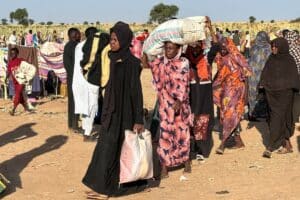Paris- France
Hunger intensified around the world in 2023, with almost 282 million people in 59 countries facing acute food insecurity as a result of conflict, particularly in Gaza and Sudan, but also extreme weather events and economic shocks, 16 UN and humanitarian organizations warned on Wednesday.
That’s 24 million more than in 2022, according to the latest global report on food crises from the Food Security Information Network (FSIN), for whom the outlook remains “bleak” for the current year.
This is also the fifth consecutive year in which the number of food-insecure people has increased.
This worsening is partly due to a widening of the areas covered by the report. This follows “new or intensified shocks” as well as “a marked deterioration in key food crisis contexts such as Sudan and the Gaza Strip”, Fleur Wouterse, Deputy Director of the Emergencies and Resilience Office at the UN agriculture agency FAO, explains to AFP.
Some 700,000 people were on the brink of starvation in 2023, including 600,000 in Gaza. This figure has since climbed to 1.1 million people in the war- and hunger-stricken Palestinian territory.
– Insufficient aid –
Since the launch of this report in 2016 by the Global Food Crisis Network, an alliance federating UN organizations, the European Union, the United States and humanitarian organizations, “the number of food-insecure people has risen from 108 million to 282 million, while prevalence (the share of the population affected within the areas concerned, editor’s note) has risen from 11% to 22%”, says Fleur Wouterse.
Since then, the food crisis has continued in Afghanistan, the Democratic Republic of Congo, Ethiopia, Nigeria, Syria and Yemen, she notes.
“In a world of plenty, children are dying of hunger. Wars, climate chaos and the cost-of-living crisis – combined with inadequate action – mean that nearly 300 million people will be facing an acute food crisis in 2023”, laments UN Secretary-General Antonio Guterres, in his foreword to the report, calling for increased contributions from States.
Especially as the costs of distributing aid have risen.
“We all know why hunger is increasing in many parts of the world, and we know the solutions. But without the resources and political will to implement them, we will continue on our current path,” warned World Food Program (WFP) Director Cindy McCain, during an online presentation of the report.
“The global food crisis is fundamentally a moral crisis,” reacted the NGO Oxfam in a statement.
“It is unforgivable that more than 281 million people are suffering from acute hunger while the world’s richest continue to make extraordinary profits, including aerospace and defense companies that help fuel conflict, the main cause of hunger,” Oxfam writes.
For 2024, developments “will depend on the cessation of hostilities”, notes Fleur Wouterse. “As soon as humanitarian access” to Gaza and Sudan is possible, aid will be able to “rapidly” alleviate the food crisis there, she says.
There are also many uncertainties concerning Haiti, “where in the Artibonite valley, the country’s breadbasket, armed groups have seized agricultural land and stolen crops”.
The El Niño weather phenomenon could also “lead to severe drought in West and Southern Africa”, adds the official.
According to the report, in 2023, conflict or insecurity became the main cause of acute food insecurity in 20 countries or territories, affecting 135 million people.
Next come economic shocks (the main cause for 75 million people in 21 countries) and extreme climatic events such as floods or droughts (72 million people in 18 countries).
On a positive note, the situation had improved by 2023 in 17 countries, including the Democratic Republic of Congo and Ukraine. “If we intervene by supporting agriculture, it is possible to get people out of food insecurity”, says Fleur Wouterse.
Humaniterre with AFP
Source photo : OXFAM





